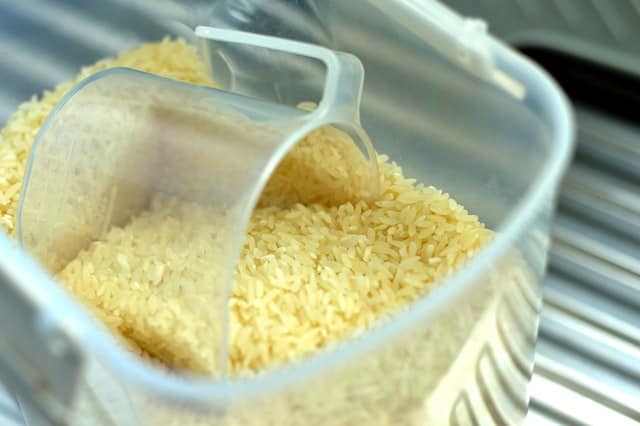
Is your dog suffering from a loss of appetite?
Does he seem weak?
It’s so hard to tell what’s wrong with a pet, as he has no way of letting you know he’s in pain.
One health issue many pet owners tend to overlook is ulcers. A dog with ulcers?
Unfortunately, yes, dogs can get ulcers just like us, and the causes are pretty much the same.
And so are the remedies, including putting your furry friend on a bland diet.
What are the symptoms of ulcers in dogs?
Most ulcers start with heartburn and discomfort after eating.
Your dog cannot complain about heartburn or reach for an antacid as you do.
This is why in many cases, a pet owner won’t suspect a thing until the illness has progressed to a point where symptoms are hard to ignore.
Ulcers are a condition where sores develop on the stomach or intestinal lining, destroying tissue and causing constant pain.
When the pain becomes intolerable you will notice that the dog is not himself anymore. He will refuse to eat as the release of digestive acids makes the pain even worse.
In many cases, the first symptoms the owner notices are vomiting and diarrhea, which is why people resort to putting their pets on a bland diet.
What is a bland diet for dogs?
A bland diet is low on protein, fat and fiber, and rich in carbohydrates.
The whole point is for the food to be soft and easily digestible, to allow the dog’s stomach to rest.
If your dog has diarrhea, his diet should be low on fiber to slow stool production.
There are some commercial bland diets on the market, but in most cases pet owners prefer homemade recipes, to make sure there are no preservatives or other chemicals in the food.
Nasty chemicals are the last thing a dog with stomach ulcers needs!
Homemade bland diet
What is the food your Mom used to give you when you had an upset stomach? Rice and lean meat, most probably.
That is exactly what you should feed your dog when he has diarrhea and is vomiting all over the place.
The meat should be either chicken breast or ground beef, but you can also use turkey breast. Both rice and meat should be boiled until cooked and mixed on a 50/50 ratio.
You could try to put in more rice than meat, like 65/35, but you run the risk of the dog being offended by such food, so it’s best that he smells enough meat in his food bowl.
The rice should be prepared separately from the meat, to avoid the absorption of too much fat.
Do not add any oil or seasoning! That’s why it’s called bland!
How much bland diet to feed a dog?
When your dog is having an acute episode of vomiting and diarrhea the first thing you need to do is withhold food or water for a couple of hours to try and ease the symptoms. Some experts say you should have your dog fast for 12-24 hours in case of vomiting and diarrhea. Not everybody agrees with this though. If the dog is already weak he will need some food to get his energy back. Fasting is not an option for a puppy!
Also, if the dog appears dehydrated, as is frequently the case with an upset stomach, try offering small amounts of water every 10-15 minutes.
How much food you should give your dog depends on his weight. A very small dog, weighing less than 5 pounds only needs 1/2 of rice and meat split into small servings to be offered throughout the day. A large dog over 100 pounds should get some 4-5 cups, also spread throughout the day in small servings. Allow at least 2 hours between meals.
Do make sure to rehydrate your dog after the vomiting and diarrhea episode. Keep in mind that a dog needs about one ounce of water for every pound of body weight per day. If you suspect the dog is dehydrated, you should add some Pedialyte, available over the counter, to his drinking water to combat electrolyte imbalances.
How long does it take a bland diet to work on a dog?
First, you need to see if the symptoms improve. If the problem is not serious, you should see some improvement over the next few hours. However, do not expect miracles. Your dog might continue to have frequent stools over the next few days. More frequent than usual, in any case.
For the bland diet to work, you need to make sure your dog sticks to it. That’s on you as the dog is unlikely to raid the fridge. Be very strict and do not allow any treats or, even worse, bones.
How long to feed a dog bland diet?
After four or five days on a bland diet, you should see a marked improvement, as far as the dog’s stools are concerned. If the diet is working, the stools should be back to normal and you can start by reintroducing regular food gradually.
Start by giving your dog a small portion of his regular food, and a bland diet for the rest of his meals.
If there are no setbacks, increase the number of normal food servings, and reduce bland diet meals.
After one week with no signs of diarrhea, you can stop giving your dog rice and feed him normally.
Bland diet for dogs – scrambled eggs?
What can you do when your dog has an upset stomach and you don’t have the ingredients or the time to make the standard rice and boiled meat recipe?
Scrambled eggs are easy to make and they are, indeed, an alternative to rice. Egg whites are best for a bland diet, as they are low in fats, but whole eggs will do just as well. It’s true that eggs have a high protein content, which should be restricted in a bland diet, but at least they’re low in fiber.
It doesn’t have to be scrambled eggs, hard-boiled eggs are a good remedy for diarrhea, but a bit more difficult to feed the dog with. However, stay away from fried eggs, which are not allowed in a bland diet.
Another option is feeding the dog plain pumpkin instead of rice. Pumpkin is a good treatment option for ulcers as it is rich in pectin, which protects the stomach lining and soothes the sores. Prepare some ground turkey and pureed pumpkin, with none of the spices used to make pumpkin pie.
Bland diet for dogs with ulcers?
All the above mentioned bland diet recipes are very good for dogs with ulcers, as you need to give his stomach a rest allowing for the sores to heal.
However, if you suspect the dog might have ulcers you should see a vet and get treatment for it. A doctor might prescribe antacids, but also antibiotics if the illness is of bacterial origin, as is often the case with us humans.
At the same time, check out some natural treatments for ulcers. Many people give their dogs licorice root, aloe vera, slippery elm, echinacea, or alfalfa as an ulcers remedy. To strengthen the dog’s immune system and prevent new ulcers from forming, try supplements such as L-glutamine and quercetin.
Bland diet for dogs with diarrhoea and vomiting?
If your dog is young and generally in good health, you don’t have to worry much about the occasional diarrhea and vomiting. In most cases an upset stomach is just that.
Put the dog on a bland diet immediately and don’t give in if he gives you a funny look when you present him with a bowl of rice and chicken.
Still, if the dog strongly protests the idea of eating rice you can try a more palatable meal with just chicken – still absolutely plain. Shredded chicken meat is easy to digest and the poor animal has to eat something. Just make sure to remove the skin and the bones.
Other options include beef, scrambled eggs and plain pumpkin. Some experts say dogs with an upset stomach could also eat baby food – meat-based commercial food intended for bigger babies. Try something with lamb, chicken or turkey, as long as it doesn’t have garlic or onions.
Or you can prepare a bone broth for your dog. Broth is very mild on the stomach, nutritious, and it tastes better than other bland diet recipes.
Bland diet for dogs with allergies?
Just as they can get ulcers, many dogs can develop food allergies. As in humans, food allergies cause rashes and itchiness, which might be hard to detect in a dog. However, food allergies can also cause vomiting and diarrhea. It’s very hard to tell if the dog has a sensitive stomach, as many pet owners claim, or there is an underlying health problem.
If you suspect your dog’s symptoms are caused by some allergy, put the dog on a bland diet until the stomach gets better. After that, you should try an elimination process. Reintroduce a new food in the dog’s diet and wait for a couple of days to see if the symptoms reappear. Repeat this process until you find the culprit, the food your dog is allergic to.
Never introduce two new foods at the same time as you won’t be able to tell which of them is the cause of your dog’s problems.
If your dog has allergies, be very careful with commercial diets, as in some cases not all the ingredients are labeled properly. Also, the fillers in pet food are sometimes what’s causing a dog’s allergy in the first place. And there are such fillers even in products marketed for dogs with a sensitive stomach.
Any sort of food can trigger an allergic reaction in dogs. The most commonly reported allergens for dogs are beef, chicken, fish, corn, dairy, or soy. Food allergies usually appear when a dog is very young, between 5 and 12 months.
Wrapping Up
There are many reasons why your dog might have an upset stomach. In many cases, it might be that the dog ate something he shouldn’t have and a bland diet will get him back on his feet in a couple of days. However, if the bland diet doesn’t seem to be working or the improvement is only mild, you should see a vet as soon as possible. Even untreated ulcers can be very dangerous for your beloved pet as it can lead to perforated ulcers when the content of the stomach spills into the body. The resulting infection can kill your dog.
At the same time, keep in mind there are other diseases that cause symptoms like vomiting, diarrhea, and weakness, some of them lethal, like parvo. When in doubt, always see a vet!
Photo Credits
¹ Photo by Matthew Lakeland on Unsplash






